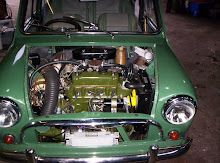Few subjects are more likely to provoke argument among rival owners than claims in respect of maximum and average speeds and m.p.g. figures. The only practical course is to tabulate some average figures which should be within the capabilities of a car that is in tip-top condition and on which the ignition and carburettor settings have been adjusted to a nicety, as described in other chapters of this book. These will be found in the Appendix.
In published road tests one often sees the 0 to 50 m.p.h. or 0 to 60 m.p.h. time quoted as a basis for comparison; but to obtain a really low figure in a standing-start test entails quite brutal engagement of the clutch at high engine revs and "snatching" of the gear changes—treatment which competition drivers accept as inevitable but which a considerate owner would hesitate to adopt. A less drastic test, and one which will give a reliable picture of the overall efficiency of the car, is to time the acceleration in third and top gears, from, say 20 to 40 m.p.h. or from 30 to 50 m.p.h.
As one would expect, a small car is appreciably livelier when only the driver is on board, as compared with a full load of passengers and holiday luggage. As a compromise, therefore, the figures given on page 147 relate to the performance that can be expected when a driver and one passenger are carried; the same applies in the case of the van, when it seems logical to assess the performance of this vehicle when carrying about half its maximum load.
The maximum speeds quoted for the indirect gears are the ultimate that can be reached, as opposed to the rather lower speeds at which one would normally change up during ordinary driving. Their chief value is an occasional check on engine condition; if the maximum obtainable in, say, second gear, falls appreciably short of the figure quoted, it is logical to suspect weak valve springs, sticking or burnt valves, retarded ignition timing or inefficient sparking plugs—faults which can be present even when an engine is otherwise in good mechanical condition and which can, fortunately, be put right quite easily by a practical owner.
Two further points deserve mention, before leaving the subject of performance. In the first place, the true maximum speed is always difficult to assess accurately. The best plan is to take the average of a series of runs in both directions over the same stretch of road, in order to cancel out the effects of wind and gradient. It is even more difficult to arrive at a true assessment of fuel consumption, as this can vary by as much as 5 m.p.g. below or 10 m.p.g. above the figures quoted, depending on road and traffic conditions, the load carried, the tyre pressures and the manner in which the car is driven.
Under most conditions, the car behaves quite well on ''mixture" grades of petrol, premium grades being an unnecessary luxury except during long, fairly fast runs in hot weather and when the car is heavily laden. The better grade of fuel will then tend to suppress any "pinking." If a "regular" grade must be used, an alternative ignition distributor is available which has a modified ignition-advance curve.
Sunday, 18 October 2009
Assessing Performance and Fuel Consumption
Labels: assessing, capabilities, consumption, cooper, deserve, figures, fuel, gears, maximum, mention, mini, performance, road, tests
Posted by Info Mini Cars at 04:46
Subscribe to:
Post Comments (Atom)


0 comments:
Post a Comment